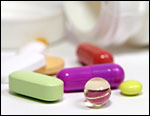
Everyone knows you have to be careful about taking more than one prescription medicine at a time, since drugs can interact in strange and dangerous ways. A Google search of “dangerous drug interactions,” for example, yields nearly 10 million hits.
Apparently the same is true of chemical contaminants in the environment. From Scientific American comes this troubling but none-too-surprising story (only part of which is free, unfortunately) suggesting that mixtures of toxic chemicals are often more potent and damaging than the compounds in isolation.
The article discusses one study of the effects of low-level pesticide contamination on tadpoles:
Individually, the chemicals had little effect on developing tadpoles at low concentrations, such as about 0.1 part per billion. But when … exposed … to all nine at the same low level in the laboratory–the lowest level actually found in the field–the future frogs fell prey to endemic infection. Those that survived ended up smaller than their counterparts raised in clean water–despite taking longer to mature into adults.
Laboratory research tends to focus on the effects of single compounds. But in real life, we’re all exposed to hundreds of contaminants at a time. And that makes the real-world effects of widespread chemical contamination both harder to understand and, at least potentially, much more serious.



